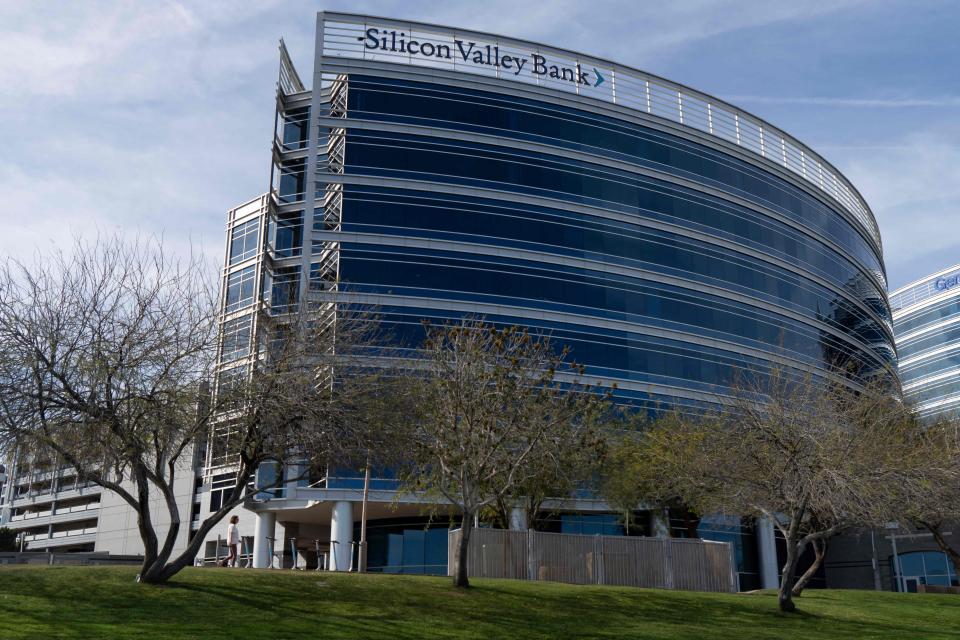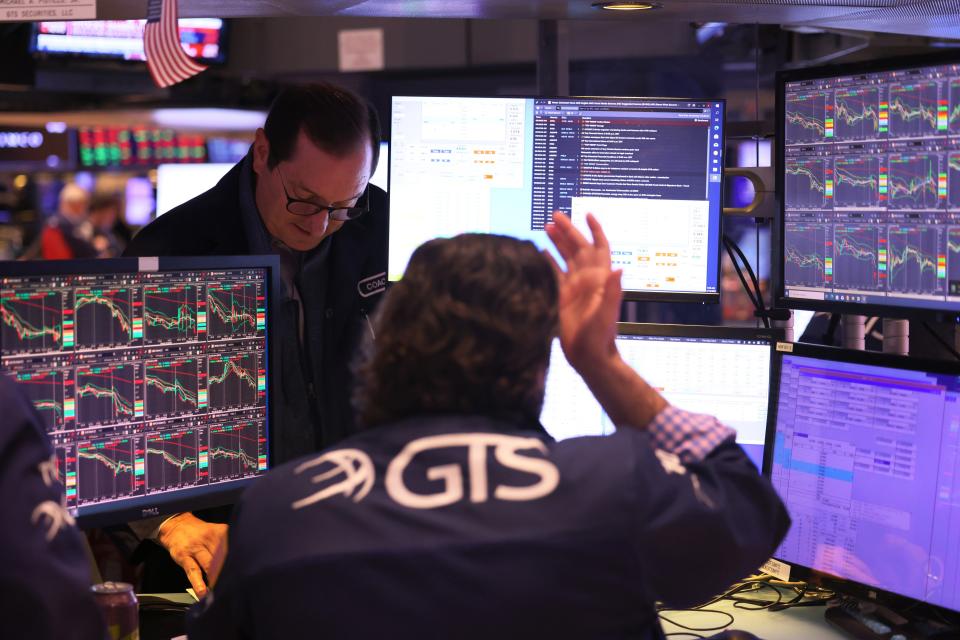A year after the first interest rate hike, Fed's next move in March is less certain
Higher interest rates ahead seemed to be a slam-dunk and then, like a lot of so-called sure-things in life, they weren't.
Just a year ago, the Federal Reserve launched its first rate hike on March 16, 2022, to cool down the worst inflation that consumers experienced in decades. So far, consumers have seen eight rate hikes through February.
The ninth rate hike was just around the corner at the Fed's next policy meeting March 21 and March 22. But the risk of a new financial crisis went up after the sudden collapse of tech lender Silicon Valley Bank in California on Friday. On Sunday, U.S. regulators took control of New York's Signature Bank, a player in the cryptocurrency space.
Now, analysts say there's a chance that the Fed could sit tight next week and not bump up rates for now.
More:Comerica, other bank stocks take hit in wake of Silicon Valley Bank failure
More:Michigan property tax bills to increase in 2023, thanks to inflation
More:Federal Reserve's smaller interest rate hike could indicate inflation easing a bit
Inflation hasn't gone away, clearly. But the Fed's top job in the coming days will be to fight another fire, the stress unfolding in a chunk of the banking system. Federal regulators calmed things down by taking emergency action to backstop deposits above $250,000 at Silicon Valley Bank and New York's Signature Bank.
On Wednesday, the Dow Jones Industrial Average turned in another tumultuous day of trading but recovered somewhat by the market close.
The Dow closed down 280.83 points or down 0.87% to end the day at 31,847.57 points. Wednesday’s woes were built on fears of a European banking crisis after shares in Credit Suisse plunged significantly.
Auto stocks tumbled. General Motors stock fell by 3.57%, or down $1.27 a share, to close at $34.33 a share.
Stellantis closed at $16.87 a share, down 66 cents or 3.76%.
Ford closed at $11.71 a share, down 22 cents or 1.84%.
“The rising risk of recession is now being exacerbated by the increased likelihood that banks will limit their lending,” said Sam Stovall, chief investment strategist for U.S. equities at CFRA Research in New York, in a report Wednesday.
Stovall told the Free Press that economically sensitive stocks, including autos and industrials, were hit Wednesday on concerns that demand for these goods and services will decline if the United States slips into a recession.
Headaches from high prices remain
A year after raising rates, the Fed's job isn't done.
The consumer price index rose at an annual rate of 6% in February. That follows a 6.4% bump in January.
Sure, inflation is down a bit after hitting a year-over-year peak at 9.1% in June — the largest increase in 40 years. But February's inflation report falls far short of inspiring.
"Inflation is still too high for the Fed," said Gus Faucher, chief economist at PNC Financial Services Group. "Shelter inflation remains very strong; we are starting to see rents decline, which should be good news."

Faucher says a rate hike of at least 25 basis points, or possibly even 50 basis points, would have been more of a certainty next week. Now, there's more room for debate.
It's still likely the Fed will initiate a 25-basis point hike next week, based on Faucher's forecast, and then possibly pause a bit. The last quarter-point hike in February put the target range at 4.5% to 4.75% for the short-term federal funds rate.
After a year of rate hikes, the Fed has been successful in keeping employment strong, Faucher said, but has missed the mark on inflation.
The rapid response by regulators Sunday to the Silicon Valley Bank and Signature Bank failures helped ease fears of widespread issues in the banking system. So, Faucher reasons, the Fed might have some room for another small rate hike next week.
Other analysts expect that the Fed will stop tightening for a bit. A Goldman Sachs report indicated that there's now considerable uncertainty about the rate path the Fed will take. The current expectation, according to that report, is the Fed won't raise rates next week but could raise rates at the May meeting and then possibly at meetings in June and July.

"The Fed is likely to take a hawkish pause at its meeting next week as it reassesses where the economy is," KPMG economist Diane Swonk wrote in a report called "Sticky Inflation."
"If the current crisis proves transitory," she said, "the Fed will resume rate hikes. Otherwise, we may be in for a harder landing."
The consumer has been resilient. Today, though, consumers are dealing with much tighter budgets after more than a year of higher prices, higher interest rates and a brutish downturn in the stock market. The Dow Jones Industrial Average closed at 35,294.19 points on March 29, 2022, a strong finish days after the first rate hike but below the record high of 36,799.65 points set Jan. 4, 2022.
The Dow has tumbled nearly 15.65% between the record close a year ago and March 13.

Just how confident some consumers, even those who are wealthy, will be when it comes to spending in the future remains questionable. If we see more stressful days for the stock market, the banking system and possibly jobs ahead, consumers could cut back spending even if the Fed doesn't raise rates further.
What could happen to interest rates?
Some interest rates — including notably mortgage and car loan rates — aren't tied directly to the short-term federal funds rate that the Federal Reserve sets at its policy meetings. And experts say those rates are likely to drop in the days ahead.
Mortgage rates tend to track 10-year Treasuries, which fell to to 3.54% Monday from about 3.97% last Tuesday according to Ted Rossman, senior analyst at Bankrate.com.
Car loans tend to track five-year Treasuries, he said, which fell to 3.68% Monday from 4.32% last Tuesday.
Given the volatility in the stock market, investors rushed to safety Monday by putting their money in Treasuries in droves and driving down yields.
Now, it's likely, Rossman said, that borrowers could see sizable declines in rates ahead for car loans and mortgages.
Credit cards and home equity lines of credit, Rossman said, track more tightly to Fed actions so borrowers are less likely to see movement on those products soon.
Someone who is shopping for a car is looking at an average car loan rate of 6.48% on a five-year car loan — up from a 3.98% average a year ago, according to data released Wednesday from Bankrate.com.
Skyrocketing mortgage rates put a lid on an ever-so-hot real estate market. The average 30-year mortgage rate hit 6.84% last week, according to Bankrate.com survey data, up from 4.14% a year ago.
But mortgage rates have pulled back and the average dropped to 6.66% now, based on Bankate.com's latest data issued Wednesday.
The average rate on a home equity line of credit — where people borrow against the equity built up in a home — shot up to 7.76%, up from 3.96% a year ago, according to the most recent Bankrate.com report. Such credit lines often are used to remodel a house, pay down other more costly debt and make big purchases.
Some consumers are under stress
Evidence of stress on some households is appearing in credit card and auto loan delinquencies and especially among consumers who have subprime credit scores, according to Cox Automotive Chief Economist Jonathan Smoke.
"This is despite very low unemployment and relatively strong wage growth," he said.
The problem?
"The consumer is juggling obligations to make ends meet," Smoke said. "And increasingly it looks like leveraging credit card debt is part of that juggling."
Credit card debt is ridiculously costly to carry. The average credit card rate is 20.04% now, according to Bankrate.com, up from 16.34% a year ago. What's more concerning is that many people with lower credit scores face far higher than average rates if they carry credit card balances or want to take out a car loan to buy a new or used car.
Right now, many consumers are able to keep spending and paying their bills to some degree, thanks to tax refund cash. But those refunds aren't as rich as they were a year ago.
The average federal income tax refund was $3,028 through March 3, based on the latest IRS data. But the average is down 11% from a year ago.
More than $127 billion in refunds has hit the wallets of consumers so far this year, down 1.5% from a year ago.
The IRS is rushing more refunds out the door earlier in the season, which is extremely helpful to many families. The number of refunds issued early in the season through March 3 is up 10.6%.
More:Tax refunds: When they're issued by IRS, why they're smaller, yet millions more are issued
More:GM puts generous buyout on the table: What salaried workers should consider
"I suspect once tax refund season fades, we’re likely to see more pullback by consumers," Smoke said.
Given that the average refund is down, Smoke said, the tax refund season isn't likely to offer the economic lift that it did a year ago.
"Consumers are receiving less and the seasonal boost to spending that we especially see in the used car market is likely to be substandard when all is said and done," Smoke said.
Retail vehicle demand fell by 10% last year. And it's tougher for those shopping for a used car to be able to afford one based on high prices and high interest rates.
"Manufacturers would rather pull back or maintain the current pace of sales than risk pushing production higher in an uncertain economic environment," Smoke said. "They could sell more, but given the pressures on consumers, they would need to cut prices and add incentives to see demand materially improved."
The luxury end of the car and truck market still has the ability to spend, Smoke said, but if a recession unfolds, even that demand would fade.
What could happen to savings rates?
Savers have been seeing some solid promotions at major credit unions, online banks and elsewhere for savings accounts and longer term savings products, such as certificates of deposit.
The average rate on a 12-month CD is 1.62% now, up from a mere 0.19% a year ago, according to Bankrate.com data released Wednesday. But it hasn't been hard to find promotional one-year CDs at 4% and 4.5%.
We might see some leveling off on rates, especially for five-year CDs, if the Fed eases off. But the promotions could continue at some banks.
Ken Tumin, founder of DepositAccounts, which is part of LendingTree and tracks and compares bank rates, said some savers could see higher CD rates offered at some institutions but lower rates might be ahead, too. Much could depend on the bank's strategy, what direction the Fed takes and the overall outlook for the economy.
FDIC-insured Ally Bank, for example, suddenly raised its 11-month No Penalty CD rate from 4% to a 4.75% annual percentage yield over the weekend. "That’s the highest rate for a no-penalty CD in the nation," Tumin said Monday. No minimum deposit. Ally calls the account online "Easy money with an easy out."
After the first six days from putting money in the CD, Tumin said, the Ally customer is free to make a full withdrawal without any penalty on the No Penalty product. He noted that higher 12-month CD rates are being offered at several online banks but those CDs don’t have this no-penalty feature.
Ally might have had reason to be aggressive, Tumin said, as the bank was included in a MarketWatch piece last week as one of 10 banks that may face trouble in the wake of the SVB Financial Group debacle.
"Before the Sunday announcements by the feds, I think Ally was worried that they could see a serious loss in deposits by skittish customers," Tumin said.
Ally did not respond to Free Press requests for comment.
After Silicon Valley Bank failed, Tumin said he believes it’s very likely that Ally decided to offer this new high rate to encourage customers to keep their deposits at Ally, noting that the new rate came out on a Saturday, which is very unusual timing for such changes.
Frankly, though, a great deal of what we're dealing with here could hardly be called routine.
Contact Susan Tompor: stompor@freepress.com. Follow her on Twitter @tompor. To subscribe, please go to freep.com/specialoffer.
This article originally appeared on Detroit Free Press: What can consumers expect after a year of rate hikes, banking failures

